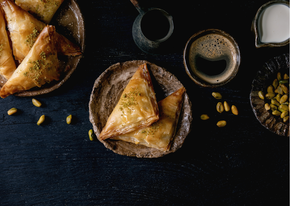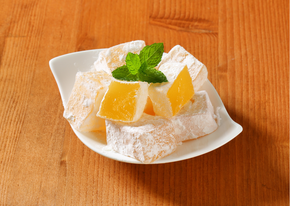Greek sweets
Greek sweets enjoy great love among adults and children in Greece, and are also very popular with tourists. Local cookies, candies, waffles, nougat and much more do not lose their freshness for a long time, so all these goodies foreigners acquire as a memory of a wonderful journey. The basis of most Greek sweets is honey and nuts, which makes not only the characteristic taste, but also high nutritional properties. For the preparation of some sweets, such ingredients are used as dry fruits, vegetable oil, milk, cream, cheese, etc.
Baklava
Sources say that it comes from Turkish cuisine, but some from Armenian or Persian cuisine, but it has become so at home in Greek cuisine that most of us consider it a Greek cake. Prepared from layers of phyllo pie, layered with a mixture of chopped nuts, poistachio or almonds, baked, soaked in sweet syrup and sprinkled with crushed pistachios.
- 200 ml of water
- 150 g of sugar
- 2 tablespoons of lemon juice, scalded, scrubbed
- 2 tablespoons of honey
- 1 packet of phyllo pastry (275 g)
- 60 g of butter, melted
- 150 g of almonds and cashews, chopped into small cubes or ground
- 100 g of shelled pistachios, finely diced or ground
- a small amount of flour to dust the dough during rolling
- Add sugar, lemon juice and honey to a pot of water.
- We put it on low heat and heat it until completely dissolved, stirring from time to time.
- Bring the syrup to a boil and cook it for 2-3 minutes until it thickens a little. Leave to cool completely.
- Smear the top of the baklava with melted butter and put it in an oven preheated to 190 ° C (without hot air), bake for about 40 minutes (until the pie rises and becomes slightly golden). If the pie starts to brown too quickly, cover it with aluminum foil.
- At the end of baking, sprinkle the baklava with pistachios. After taking the dough out of the oven, pour the cooled syrup over the cut lines. Let it cool down.

Lukumi
Lukumi is one of the best known traditional Greek delicacies. These very sweet cubes, at first glance, resembling jelly, are made of wheat starch with added sugar, rose water or fruit juices. All ingredients are distinguished by the highest quality. After being bitten, it becomes extremely delicate, and at the same time slightly pulling. the cubes sprinkled with powdered sugar are also a feast for the eyes. The most popular flavors are rose, bergamot and masticha.
- Sugar syrup:
1 kg of sugar
300 ml of water - Starch milk (starch):
100g of corn, rice or wheat starch,
200ml of boiled, cool water - To cover lukumi:
100g of powdered sugar,
a packet of vanilla sugar - For cooking lukumi:
3-4 tablespoons of jam syrup or fruit puree,
2 teaspoons of orange or lemon zest,
a drop of rose oil,
100g of shelled, crushed nuts and almonds,
1 pinch of saffron or turmeric
- Boil the sugar syrup, add the starch milk over high heat and, reducing the heat, stir constantly with a wooden spoon until the mass thickens.
- Add the remaining ingredients in the following order: fruit puree or jam syrup, spices, rose oil, nuts. Boil until semi-liquid, while stirring constantly, do not allow it to burn.
- Pour the ready mass into the prepared form with a 2.5 cm thick layer, wait 3-4 hours until it solidifies, then cut into small cubes and sprinkle with powdered sugar with vanilla sugar.

FRUIT IN SYRUP
A Greek delicacy meaning fruit prepared in a very sweet syrup. Such delicacies are sometimes offered by taverns at the end of the main meal, and it is also a popular addition to desserts. Trying them can be a real test of resistance to the Greek definition of sweets. Frequently served coffee to guests along with Greek yoghurt.
- 1 kg of any ripe fruit
- 1 kg of sugar
- 1 teaspoon lemon juice
- 1 larger cup of water
- vanilla
- Pour sugar into the pot, pour water over it and cook, stirring constantly, taking care not to burn the sugar. When the sugar dissolves and the syrup boils, take the pot off the fire and cool it down a bit.
- While the syrup cools down, wash the fruit and remove the seeds if necessary.
- Put the pitted fruit into a pot with syrup and start cooking over a fairly strong fire. In the initial stage, foam will appear, which should be gently pulled off. If necessary, we reduce the fire to medium.
- When the syrup thickens a bit, add lemon juice and possibly a pinch of vanilla.
- You must remember not to cook for more than 15-20 minutes. After this time, the fruit will start to shrink and its taste will not be as good. We know from our experience that these fruits are best suited for fairly short and vigorous cooking. Then they retain their taste and firmness.
- Preserve Glyka tou koutaliou in jars. After cooking, put the fruit into smaller jars and pour it over with the resulting syrup. It is a good idea to leave a little slack in the jars and do not force them into the jars, trying to fit as many fruits as possible. Then preserve in airtight jars and cool.
CHAŁWA
In Greece, sesame halva is not treated as a sweet. It is very popular to eat halva served with lemon as a snack with coffee or tea. Just before eating, the halva is sprinkled with lemon juice, thanks to which it acquires a sweet and sour taste. It tastes great with cold wine. Even in an ordinary shop, we will not find halva on the shelf with sweets, rather next to cheeses and olives.

!Enjoy your meal and invite you for more!

